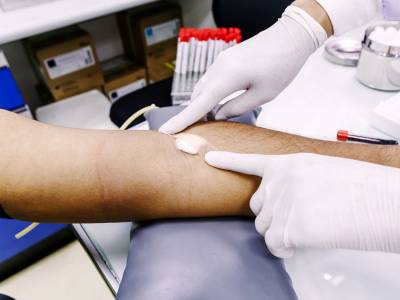Serum Angiotensin Converting Enzyme (ACE)

Angiotensin-converting enzyme (ACE) is an enzyme that helps regulate blood pressure. An increased blood level of ACE is sometimes found in sarcoidosis, a systemic disorder of unknown cause that often affects the lungs but may also affect many other body organs, including the eyes, skin, nerves, liver, and heart., This test measures the amount of ACE in the blood.
A classic feature of sarcoidosis is the development of granulomas, small tumor-like masses of immune and inflammatory cells and fibrous tissue that form nodules under the skin and in organs throughout the body. Granulomas change the structure of the tissues around them and, in sufficient numbers, they can cause damage and inflammation and may interfere with normal functions. The cells found at the outside borders of granulomas can produce increased amounts of ACE. The level of ACE in the blood may increase when sarcoidosis-related granulomas develop.
The angiotensin-converting enzyme (ACE) test is primarily ordered to help diagnose and monitor sarcoidosis. It is often ordered as part of an investigation into the cause of a group of troubling chronic symptoms that are possibly due to sarcoidosis.
Sarcoidosis is a disorder in which small nodules called granulomas may form under the skin and in organs throughout the body. The cells surrounding granulomas can produce increased amounts of ACE and the blood level of ACE may increase when sarcoidosis is present.
The blood level of ACE tends to rise and fall with disease activity. If ACE is initially elevated in someone with sarcoidosis, the ACE test can be used to monitor the course of the disease and the effectiveness of corticosteroid treatment.
A health practitioner may order ACE along with other tests, such as AFB tests that detect mycobacterial infections or fungal tests. This may help to differentiate between sarcoidosis and another condition causing granuloma formation.
When is it ordered?
An ACE test is ordered when someone has signs or symptoms that may be due to sarcoidosis, such as:
- Granulomas
- A chronic cough or shortness of breath
- Red, watery eyes
- Joint pain
This is especially true if the person is between 20 and 40 years of age, when sarcoidosis is most frequently seen.
When someone has been diagnosed with sarcoidosis and initial ACE levels were elevated, a health practitioner may order ACE testing at regular intervals to monitor the change in ACE over time as a reflection of disease activity.
What does the test result mean?
An increased ACE level in a person who has clinical findings consistent with sarcoidosis means that it is likely that the person has an active case of sarcoidosis, if other diseases have been ruled out. ACE will be elevated in 50% to 80% of those with active sarcoidosis. The finding of a high ACE level helps to confirm the diagnosis.
A normal ACE level cannot be used to rule out sarcoidosis because sarcoidosis can be present without an elevated ACE level. Findings of normal ACE levels in sarcoidosis may occur if the disease is in an inactive state, may reflect early detection of sarcoidosis, or may be a case where the cells do not produce increased amounts of ACE. ACE levels are also less likely to be elevated in cases of chronic sarcoidosis.
When monitoring the course of the disease, an ACE level that is initially high and then decreases over time usually indicates spontaneous or therapy-induced remission and a favorable prognosis. A rising level of ACE, on the other hand, may indicate either an early disease process that is progressing or disease activity that is not responding to therapy.
- Comment
- Posted by Dayyal Dg.